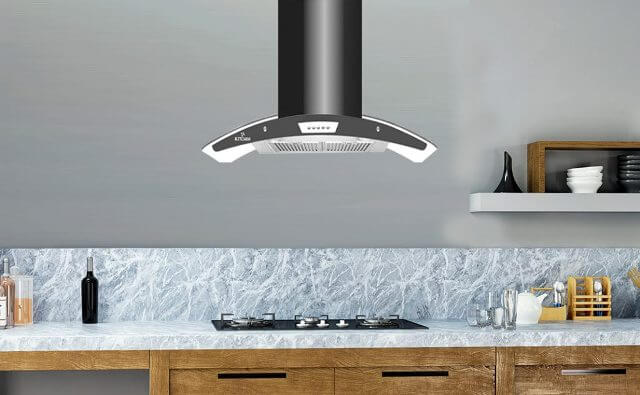
Many accessories are available for wood stoves. Some are for performance enhancement, while others can be used to enhance the atmosphere or decorate. We will be covering the basics.
Accessories of Stoves
Chimneys
Though chimneys are not an accessory for a stove, it offers a great deal of convenience for users. It is important for you to check and compare different kinds of chimneys found in the market based on your requirement. The advanced auto clean technology has offered a wide room to use without paying much for maintenance. Know why to use an auto clean chimney because it makes a huge difference in the room. Some of the Inalsa kitchen chimneys can offer you the best performance without compromising on the budget.
Ash Vacuum
The majority of household vacuum cleaners are not capable of filtering out finer particles than wood ash. You should not attempt to vacuum more than a small amount or accidentally pick up a coal. This could cause dust to blow around the room and ignite the vacuum. A special vacuum cleaner designed for shattering stoves includes a super-fine filter or filters and usually a fire-resistant prefilter.
Retrofits of catalytic units.
Catalytic retrofits were popular before catalytic combustors were commonplace in woodstove designs. The catalytic unit was mounted much the same as a pipe damper. It had a handle that allowed the user to close or open it. The catalytic combustor was placed in the pipe to allow smoke to pass through when it was “closed”. Although it was a great idea, the results were not always satisfactory. The catalytic combustor is mounted outside of the stove’s body, making it difficult to achieve the required temperature for catalytic combustion. Therefore, the units did not work well.
Gaskets
When it’s time to replace gaskets, note the model number of your stove and the length of the gasket you need. Visit your local stove shop to learn what you need and how you can do it. Note: Bring any loose gaskets with you. You can also hire a chimney professional to handle the job.
The maintenance section in your stove owner’s guide should be read. This section will provide information about the specific maintenance required for your stove model, including cleaning out burn tubes and replacing them with newer ones. These procedures are simple and cost-effective and will keep your stove running at its best.
Fans
The stove heat is circulated by fans. Stoves with a circulating design (see page 47) can often be fitted with a blower at the back to push air through the air channels into the room.
Ceiling fans and small fans mounted in doors have the same effect: They move air around and distribute heat.
Consider the space you want to heat before you install a blower or fan on a stove. The hot air must be able to move into the room and the cooler air must have a way back to the stove. To create air circulation throughout the area, set up the fan system.
Glass cleaner
There are two types of stove glass cleaner. The pump-spray can remove mild stains. This is a good choice for stove users who clean their glass often. The liquid paste type is better if you are prone to letting it get very filthy. Even the most severe creosote buildups will be removed by this liquid paste, but you might still need to work at it if it gets really bad.
Gloves Gloves for woodburners are essential to prevent burns during stove loading. In an emergency, a good pair of gloves will be able to reach into the stove and move a log.
Heat shields.
Stoves made from steel are available with optional heat shields. These panels attach to the bottom or back of the stove to reduce heat loss to combustible materials. For example, some stove brands require a bottom heat shield for installation on hearths with wooden supports underneath. You may also want to move your stove closer to a combustible walls in other situations. A rear heat shield allows for reduced clearances.
Take care to follow all manufacturer’s instructions. Never place your stove any closer than the minimum distance that is required by the manufacturer. For more information, contact your local stove shop.
Outside air duct adaptor.
If your house is very well insulated or if local codes or state regulations require it, you can “pipe” air to the stove from the outside. Some stoves do not have an air intake that can accept a round pipe. The outside air duct adaptor, which is a metal connector attached at the intake with a round-flanged end, allows for the connection of a round pipe to the outdoors.
Spark screen.
Stoves can be used with the front doors opened, just like a fireplace. For open fire viewing, a spark screen that fits the front opening is essential.
Steamers.
You can choose the one that you like, but smaller ones may need to be filled more often – sometimes several times per day. Avoid letting it boil, especially if you have a ceramic one. It might crack. Put a trivet underneath the steamer if the water is boiling.
A trivet is a great idea if you have an enamel stove top. This will help to avoid damaging the enamel or scratching the enamel by boiling water over it.
Stove thermometer.
The stove thermometer is used to measure the stove’s temperature. It can be either a probe-type or surface-mounted model. The probe-type thermometers measure flue gas temperature more accurately by inserting a probe into the pipe.
A lot of catalytic stoves can accept a probe-type thermometer. To monitor the operation of the catalytic units, the probe should be inserted directly above or behind them.
Warming shelves.
Some stove models include optional warming shelves. These decorative shelves are attached to the stove’s sides. These shelves are used to heat stew and provide storage space for steamers when loading top-load stoves (stoves with a load door at the top).










